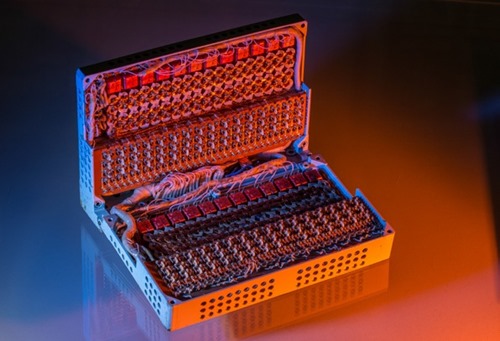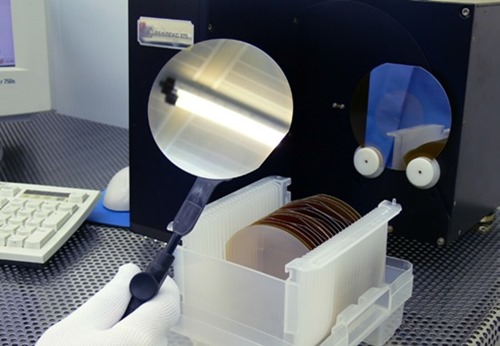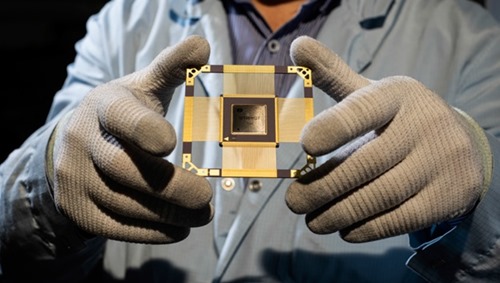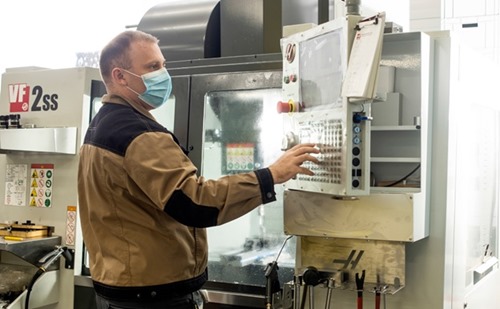SEZ Technopolis Moscow supports space developments
/Planet_earth.jpg)
Moscow is the leading center of the aerospace industry in Russia, with more than 40 ventures of the sector located here. Over the years, more than 100,000 people of labor and science have contributed to the formation of the space age.
In order to become the first in space, Soviet scientists, engineers, designers, and workers had to become the first on Earth - the first in research, testing, inventions, in the promotion of science and new technologies - the first in everything. Often the working conditions were challenging with “top secret” stamps at many stages, with stress tests, failure and triumph, an arms race and fortitude, faith in the victory and 24/7 work for the benefit of the Motherland.
It is hard to overestimate the contribution to the space exploration made by the capital's enterprises: some of them have remained at the forefront for almost 100 years, implementing the global dream and the desire to study and comprehend the Universe. A large contribution to the development of the space industry is made by microelectronics companies with about 15 of them involved in research and development for space and operating in SEZ Technopolis Moscow.
Angstrem
The pilot plant Angstrem was set up more than half a century ago at the Research Institute of Precision Engineering. A pioneer of national space electronics, it was part of the Soviet Silicon Valley - a microelectronic cluster comprising a scientific center, dozens of research institutes and radio electronic factories. Angstrem took part in the studies of the first integrated circuits for the Soviet lunar program. Nowadays, not a single Russian launch vehicle or satellite is complete without their microcircuits.
Interesting facts
Ordinary gadgets won't work in space. At best up to 500 km from the surface of the Earth. The magnetic field of our planet protects us from cosmic radiation, but the Moon has no protection from it. Even a thick layer of lead is not protection.
The first spaceships, although they had automated response, did not have microelectronics and an on-board computer. Therefore, in 1962-1965 Angstrem generated the design and production process for the first microcircuit in the USSR - 1MD4 Tropa-1.
On the basis of Tropa-1, the first on-board computer Argon-1 for ballistic missiles and Argon 11C for automatic flight control of Zond series spacecraft were created. The spacecraft of this series were intended to study the possibility of Soviet cosmonauts landing on the lunar surface.
Zond-7 was unmanned and controlled by an onboard computer for the entire eight days of the flight with a reliability of 99.999%. Such reliability was ensured not even by duplication, but by tripleting of computing units. The computer selected the correct one out of three signals. Zond-7 was launched on August 8, 1969 with a model of the cosmonaut. It flew around and photographed the Moon, returned to Earth, bringing the first color photographs of the satellite's surface.
"Buran" and later spacecraft were equipped with microcircuits, well protected from space radiation. Many of the developments of the 80s are still in use. It is the reliability of Angstrem products that enabled satellites to stay in orbit for many years.
By the way
Today, Russian cosmonautics is preparing for a new flight to the Moon, and new highly reliable microcircuits are being created for this expedition. For example, to increase the radiation resistance, the "silicon on sapphire" technology has been introduced. Sapphire - aluminum oxide - has a high insulating ability: products on such a basis have no “parasitic currents” disrupting the equipment, thanks to which the electronics are resistant to cosmic radiation.
A thin layer of silicon is deposited on the sapphire base, from which the microcircuit structure is built. A 32-channel processor and multiplexer, wide-band precision operational amplifiers and a lot more have been worked out to process control and measuring signals and telemetry equipment.
ELVIS
JSC scientific production center ELVIS was founded in March 1990 on the basis of a structural unit of the scientific and production association ELAS, which carried out advanced researches in space electronic technology in 1960-1980: from the design of its own CAD systems to fully complete hardware and software onboard control systems and processing space-based information of the Salyut series, in particular, those that operated on board the Mir station. In 1974, the USSR's first microprocessor set of ultra-large-scale integrated circuits was developed while in total there were more than 400 of them. Today, the company develops "System-on-Crystal" microcircuits based on its own design platform MULTICOR.
By the way
Microcircuits MULTIBORT have a powerful software ecosystem and a debugging platform, ensuring a significant economic effect in terms of reducing the development time of target devices by consumers.
Interesting facts
JSC SPC ELVIS has elaborated and maintains a line of microcircuits MULTIBORT - a domestic set of microcircuits resistant to the influence of special factors, provided with innovative channels with a packet transmission of information SpaceWire / SpaceFibre and united by a general concept of building onboard equipment.
For the first time in the Russian Federation, ELVIS implemented SpaceWire network interfaces, as well as GigaSpaceWire and SpaceFibre gigabit interfaces as part of processor and switch microcircuits, which are widely used in various devices.
All microcircuits of the set are united by a single concept of building onboard communications for multiprocessor distributed fault-tolerant onboard equipment. Each microcircuit (microprocessor, multichannel adapter, peripheral controller or switch, etc.) can be used as a network element of complex onboard equipment, including spacecraft, based on SpaceWire / SpaceFibre networks with the use of "smart" switch-routers and others microcircuits of the set MULTIBORT developed by JSC SPC ELVIS and its partners.
EPIEL
Experts of the Moscow enterprise EPIEL focus on epitaxial structures. That is crystalline materials necessary for every single complex electrical device and apparatus sent into space. EPIEL JSC is a leading Russian manufacturer of epitaxial structures based on silicon and sapphire for a wide range of semiconductor devices, including integrated circuits, discrete power devices and many other electronic components.
EPIEL covers 80 percent of the domestic electronics industry and is unique in its field not only in Russia, but also in the world. Scientists and engineers of EPIEL are developing technologies of the future - those that will be useful for radio electronics engineers in a dozen years. Today, more than 50 enterprises of radio electronics throughout Russia are consumers of the company's products.
Test-Contact
Any electronic item, be it a flashlight or a supercomputer works due to the contacts between its parts. The Moscow company Test-Contact aims to completely exclude the failure in the connection between the parts (and hence the failure of the whole device). With its own design bureau and manufacturing base in the capital these problems are solved in the shortest possible time. Since 2011, Test-Contact LLC with its own equipment has been producing contacting devices for all types of electrical radio products, including for the space industry.
Interesting fact
For such an aggressive environment as space, the reliability of contact is crucial. The company's products are capable of failure-free operation at temperatures from –60 to +260 degrees, while maintaining mechanical characteristics as well as withstand stretching, bending, shaking, exposure to radiation, power surges... Test-Contact devices are used by all leading enterprises of the national space industry because of their reliability.
By the way
Test-Contact LLC devices are used for testing the electronic component base for highly reliable aircraft, land and marine equipment, medical and space businesses. They allow you to check the quality of almost any microelectronic unit: from prototypes to final products. At the same time, the company is the only developer and manufacturer of contacting devices for testing electrical radio products in Russia.
/)






/canvascolor(0xffffffff)/2017_07_25_Germany_Technologiepark_Heidelberg.jpg)
/canvascolor(0xffffffff)/Incuba.png)
/canvascolor(0xffffffff)/QU_LOGO.png)
/canvascolor(0xffffffff)/KENNISPARK-TWENTE_FC-LOGO-1-800x220_1.png)
/canvascolor(0xffffffff)/RSTP_Logo-01_8.png)
/canvascolor(0xffffffff)/GEP_Logo-01_transparant_(1)_6.png)
/canvascolor(0xffffffff)/atap_logo.png)
/canvascolor(0xffffffff)/MemberLogo-5701-6142.jpg)
/canvascolor(0xffffffff)/2018_01_25_Italy_Comonext.png)
/canvascolor(0xffffffff)/2017_07_31_tecnopuc.png)
/canvascolor(0xffffffff)/buildings2.png)
/canvascolor(0xffffffff)/2017_11_10_Turkey_Bilkent_Cyberpark.png)
/canvascolor(0xffffffff)/PCT-GUAM_-LOGO-NORMAL_1.png)
/canvascolor(0xffffffff)/2020_10_09_Spain_Geolit.jpg)
/canvascolor(0xffffffff)/buildings2_7.png)
/canvascolor(0xffffffff)/2020_05_07_Brazil_Porto_Digital.jpg)
/canvascolor(0xffffffff)/2024_Nigeria_Solution_Innovation_District.jpg)
/canvascolor(0xffffffff)/2017_07_31_University_of_Iceland.jpg)
/canvascolor(0xffffffff)/2025_09_16_Sweden_Medeon_SP.png)
/canvascolor(0xffffffff)/Korea_Innovation_Foundation.png)
/canvascolor(0xffffffff)/STH-Tech_logo_USUEL_RGB_NOIR_vsF_avril_21_1.png)
/canvascolor(0xffffffff)/2023_06_08_Australia_Melbourne_Innovaiton_District.jpg)
/canvascolor(0xffffffff)/2025_09_05_France_Atlanpole.jpg)
/canvascolor(0xffffffff)/TusPark_Belgium.png)
/canvascolor(0xffffffff)/MemberLogo-61901-312801.png)
